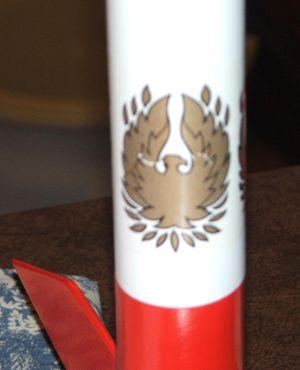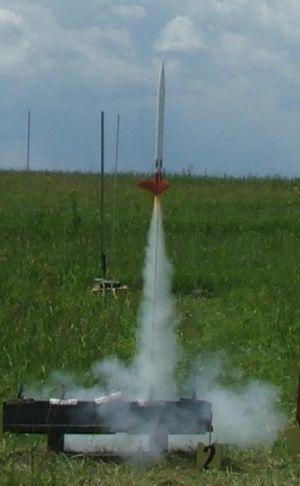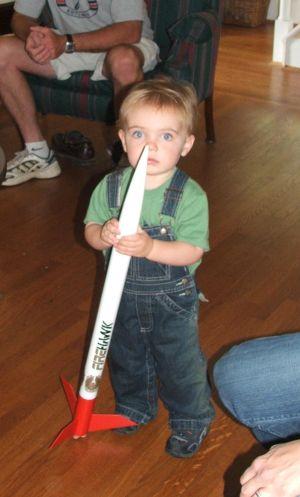| Manufacturer: | Estes  |

Brief:
This is a stock Estes Firehawk (the BT-60 based version) with a 3x18mm cluster in place of the standard single 18mm engine. The Firehawk was an auction win from eBay and was initially purchased with an eye toward using the nose cone to clone a National Aerospace Plane. That all changed after I realized what a unique looking bird the Firehawk was and that it was BT-60 based and would lend itself easily to clustering.
Modifications:
Ever since rediscovering the remains of my half built Estes Super Vega in 2001, realizing that most of it wasn't salvageable and therefore ripe for modification, I've had a thing for clustering BT-60 based rockets. For the Firehawk project I had a cluster mount already completed and gathering dust on my desk, which was a major factor in the decision to turn it into a cluster. Having the mount already built made just made it easier. I'd probably have clustered it anyway. Aside from the cluster, the only other change that I made was the now standard anchoring of the Kevlar shock cord into the upper centering ring. Everything else about the build went just as specified in the instructions, which are fairly easy considering that the Firehawk is just an oversized 3FNC rocket.
Construction:
The parts list:
- PNC-60RL
- BFS-40L (1/8" balsa)
- BT-60R (5")
- BT-60 (18")
- JT-60C tube coupler
- 3 BT-20J engine tubes
- 3 RA-2050 centering rings for engine blocks
- 2 RA-2060 centering rings
- 2 LL-2B launch lugs (3/8")
- 12" nylon parachute (from Thrustline Aerospace)
- 36" Kevlar shock cord (from Thrustline Aerospace)
- 36" 1/8" sewing elastic shock cord
- 2 large snap swivels

Finishing:
Although a fairly large rocket, the Firehawk was surprisingly simple to finish in large part due to it being built in two separate sections. Once I had securely glued the engine mount into the fincan and plugged all of the potential exhaust leaks, I attached the fins and used thinned Elmer's Fill 'n' Finish to eliminate the tube spirals and balsa grain. This was where not connecting the sections in a rocket like this pays dividends. After priming the whole rocket with Valspar primer, I took an section of scrap BT-60, slipped a tube connector into the fin can, and used the scrap BT-60 as a paint stand. I sprayed the fin section with several coats of Testors Bright Red Gloss, which was an incredibly bad choice. It took five coats and a whole can of the Testors paint to do the small fin section because of the paints inability to cover well. It wound up being a good color choice, but I don't think I'll be buying any more Testors paints in the future. The top section was painted in the same way as the bottom as far as the tube connector and scrap of BT-60, but the Valspar gloss white covered in two coats. When the two sections were dry I glued them together using the tube connector and prepared to apply the decals. I didn't think this would be a problem because I considered the Firehawk a kit of fairly recent vintage. At the time I didn't know that it was produced only in 1989-90, which made the decals fifteen years old at the minimum. This became obvious as they started to come apart as soon as I tried to slide them off of the backing paper. The Firehawk isn't overly laden with decals as there are only three, but it took me over two hours to get them on and looking decent. From a distance the mess isn't evident but please try to be no closer than five feet if you're looking it over.

Flight:
While far from my first cluster, the Firehawk was easily one of the most impressive. Despite encountering my age old launch lug bugaboo and have to super glue a set on just before I took it to the pad, I was optimistic about it's first flight and loaded it with a trio of C6-5s despite the windy conditions. Unlike my previous, bulkier attempts at clustering, the Firehawk really screamed off the pad--a truly "now you see it, now you don't" flight and definitely one too quick for my meager launch picture taking skills. It cocked into the wind and was just a dot when the ejection charges fired but it was pretty obvious that ejection happened early. As usual, the windcocking was a blessing in disguise as recovery took me out almost to the dog park with it. (A straight flight might have left the park altogether.) The long walk did allow me to recover several rockets that flew after mine, so at least someone benefited.
The second flight came two weeks later and was also done on a trio of C6-5s. The flight was as impressive as the first one had been and looked to be quite a bit higher, but the ejection seemed to come quite a bit early. It was after the flight that the real adventure began. The flight had been quite high and the winds came on strong just before the Firehawk was launched. It windcocked somewhat but lacked the fin area for it to be enough when it came to recovery. We watched it as it drifted to the east and out of the park. Having learned from past mistakes, I saddled up the van and drove over to the site but found nothing. I climbed the park fence and followed the path along the area that we had sighted from the pad and still came up empty. I decided to make one more pass along the edge of the subdivision across from the VOA before I gave up but this was turning up nothing as well. I had literally just thought that the search was a lost cause when a lady came out of a house and asked if I was looking for the rocket. I had been within twenty feet of it the whole time but it had nestled into the grass perfectly so that it wasn't visible from any vantage point. It was barely even visible as I stood almost on top of it.

Summary:
PROs: The Firehawk is a great looking bird when built and finished in the factory scheme. The forward swept fins look great and the BT-60 size makes for a satisfyingly large and sturdy finished product. Great performance with the cluster.
CONs: Wimpy 18mm power for a rocket of this size when built stock. At the very least this one should have been D powered. Decals didn't age well.
Other Reviews
- Estes Firehawk By Donald Besaw Jr
Brief: This is a new 2004 release from Estes. It is an E2X series rocket that can be built in an hour or less. It flies on mini motors up to 500 feet and uses a parachute for recovery. Construction: The kit came in a plastic bag with header card and consists of a minimal amount of components. The kit included:- 2 motor mount/fin sections 2 retension caps 1 ...
 |
 |
Flights
 |
 |